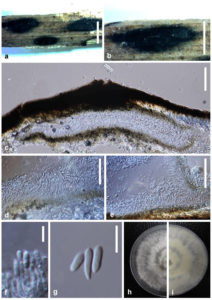Diaporthe torilicola Dissanayake, Camporesi & K.D. Hyde, sp. nov., Index fungorum number: IF553192
Etymology: The specific epithet torilicola is based on the host genus (Torilis).
Pathogenic on Torilis arvensis (Huds.). Sexual morph: Not observed. Asexual morph: Conidiomata up to 300 μm in diameter, superficial, solitary, scattered on PDA, globose, dark brown to black, clustered in groups of 2–5 pycnidia. Peridium 16–20 μm thick, inner layer composed of light brown textura angularis, outer layer composed of dark brown textura angularis. Conidiophores 21–35 × 1.5–2.5 μm ( x̅ = 27 × 2 μm), cylindrical, aseptate, densely aggregated, straight or sinuous, terminal, slightly tapered towards the apex. Alpha conidia 6–8.5 × 2–3 μm (x̅ = 8 × 3 μm) hyaline, biguttulate, fusiform or oval, both ends obtuse. Beta conidia 18–37 ×1–1.5 μm (x̅ = 27 × 1.5 μm) hyaline, aseptate, filiform, hamate, guttulate, tapering towards both ends.
Culture characteristics: Colonies on PDA covering entire Petri dishes after 10 days, grey, with scant aerial mycelium; reverse fuscous black. Colonies on PDA flat, with entire edge, cottony, olivaceous buff, with aerial mycelium in concentric rings, with olivaceous patches; colonies reaching entire petri dish after 2 wk at 25 °C; reverse olivaceous buff and greenish olivaceous.
Material examined: ITALY, Forlì-Cesena Province, Monte Pallareto – Meldola dead aerial stem of Torilis arvensis (Apiaceae), 12 April 2016, Erio Camporesi; (MFLU 16-1166, holotype); ex-type living culture MFLUCC 17-1051.
Notes: In the phylogenetic analysis, D. torilicola forms a sister clade to D. toxica. Williamson et al. (1994) designated the name D. toxica for the sexual state of the toxicogenic variety, P. leptostromiformis var. leptostromiformis. Phylogenetically, D. toxica differs from D. torilicola by 92 nucleotides in the concatenated alignment, in which 26 were distinct in the ITS region, 27 in the TEF region, 17 in the BT region and 22 in the CAL region.
Fig. Diaporthe torilicola (MFLU 16-1166, holotype). a, b Conidiomata on host surface. c Cross section of conidiomata. d–f Conidia attached to conidiogenous cells. g Alpha conidia. h, i Culture on PDA after one week. Scale bars: a, b = 0.5 mm, c–e = 100 μm, f, g = 10 μm.

